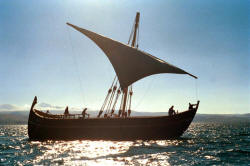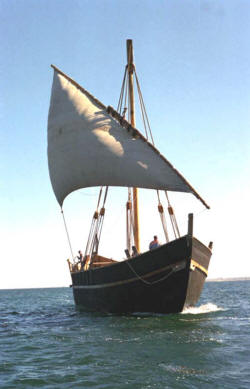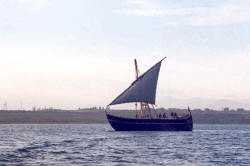Replica of 13th Century Medieval Merchant Sailing Ship Cilicia to Retrace Ancient Armenian Maritime Trading Route,
Starting Summer 2004 — Part I
By Jackie Abramian (as published in the Armenian Press)
 LAKE SEVAN – In the landlocked country of Armenia (the smallest of the former Soviet republics), floating upon the channel harbor of Armenias Lake Sevan, 1,916 meters above sea level, is a medieval sailing ship called CILICIA, which is awaiting its Seven Seas Expedition to retrace the ancient Armenian maritime trading route. As we near the ship, black clouds darken over the majestic Lake Sevans unpredictable waters sudden waves rock the boat as we climb into CILICIA welcomed by its soft-spoken, bearded Captain, Karen Balayan, whose gentle smile and piercing eyes are partially hidden under a baseball cap. More than 15 years in planning and building, CILICIA is the result of the commitment of a group of 25 volunteer professional sailors who spent their weekends, dexterity and in-depth knowledge of Armenias maritime and ship building history to reconstruct a replica of a medieval Armenian sailing ship from the Cilician Armenian Kingdom (XII-XIV c.c.).
LAKE SEVAN – In the landlocked country of Armenia (the smallest of the former Soviet republics), floating upon the channel harbor of Armenias Lake Sevan, 1,916 meters above sea level, is a medieval sailing ship called CILICIA, which is awaiting its Seven Seas Expedition to retrace the ancient Armenian maritime trading route. As we near the ship, black clouds darken over the majestic Lake Sevans unpredictable waters sudden waves rock the boat as we climb into CILICIA welcomed by its soft-spoken, bearded Captain, Karen Balayan, whose gentle smile and piercing eyes are partially hidden under a baseball cap. More than 15 years in planning and building, CILICIA is the result of the commitment of a group of 25 volunteer professional sailors who spent their weekends, dexterity and in-depth knowledge of Armenias maritime and ship building history to reconstruct a replica of a medieval Armenian sailing ship from the Cilician Armenian Kingdom (XII-XIV c.c.).
The reconstruction, in strict accordance with the information culled from medieval manuscripts, utilized techniques and technologies available in the 13th century. At snail pace, the ship slowly came to existence in the village of Massis, 20 minutes from Armenias capital city of Yerevan as financial assistance trickled in from angel funds. Finally, in May 2002, almost to everyones disbelief, the ship was completely built and ready to be towed from Massis to Yerevans Republic Square where it sat for public viewing. Later in May, the ship was towed the 45-minute distance from Yerevan to Lake Sevan as the crew anxiously followed the tow truck and crowds escorted the ancient vessel. Once at Sevan, the ship was blessed, named CILICIA and baptized with a slow push into the freezing waters where it would winter.
 That September, Armenias president, Robert Kocharian himself a sailor visited the ship and was so impressed that he donated the funds needed for the ropes to put the ships sails in place. Since its entry into Sevan, the crew has conducted sailing exercises on the Lakes ever-changing waters, awaiting sponsors, in addition to the angel funders thus far, to realize their two-year, seven-seas expedition.
That September, Armenias president, Robert Kocharian himself a sailor visited the ship and was so impressed that he donated the funds needed for the ropes to put the ships sails in place. Since its entry into Sevan, the crew has conducted sailing exercises on the Lakes ever-changing waters, awaiting sponsors, in addition to the angel funders thus far, to realize their two-year, seven-seas expedition.
SEVEN SEAS EXPEDITION
CILICIAs Seven Seas Navigation expedition will take her through 40 major harbors, in 21 countries and three continents. Planned for June 2004, the expedition will be launched with the ship flying Cilician-era Armenian flags, being towed to Batumi, on the Black Sea. From there the ship will sail through the Marmara, Aegean, editerranean and Adriatic seas to arrive in Venice in September of 2004 where the ship will winter. The crew will return home to Armenia and, in the spring of 2005, will return to Venice to start the second stage of the expedition that will take the ship from Venice to circle Europe and arrive in Amsterdam by September 2005.
We plan to have a crew of 14 on board, says Captain Karen Balayan pursing his lips. We foresee perhaps having on board one or two guests, representatives of the countries visited, officials or honorable persons on the short one-day stages of the trip. The crew hopes to obtain funds to have period-designed clothes tailored so they can wear the attire during their expedition to educate the public about the history, tradition, culture and maritime practices of ancient Armenia. In addition, the ship will carry symbolic representation of the periods cargo carried by similar Armenian ships while the crews diet will reflect the period cuisine no tobacco, no potatoes only fish and seafood, in addition to dried meats. Our cook is now testing these foods on us, smiles Karen Balayan as we take refuge from piercing winds to the lower level of the ship. We gather around the wooden table made by the crew out of authentic Cilician wood brought from Turkey and are warmed by the tight quarters of bunk beds on either side and the aroma of fried fish and steaming potato and  parsley soup that the cook offers us in small bowls. Todays meal is not representative of those times, of course, laughs Balayan. As we toast Captain Balayans birthday, we wish the crew a safe launch into their upcoming journey, anticipated for more than a decade. The sunburned faces of the crew around the table affirm a commitment to a project started as an idea and realized into a fully functioning ship.
parsley soup that the cook offers us in small bowls. Todays meal is not representative of those times, of course, laughs Balayan. As we toast Captain Balayans birthday, we wish the crew a safe launch into their upcoming journey, anticipated for more than a decade. The sunburned faces of the crew around the table affirm a commitment to a project started as an idea and realized into a fully functioning ship.
At the lower level of the ships tight quarters soft, wooden bunks stack against the body of the ship to accommodate the 14 crew members. Right outside the dining area, in a tight corner niche sits the kitchen. The cook has a most challenging job of feeding hungry and exhausted crew, says Balayan as he leads us to the opposite end of the ship, beyond the dining hall, into the tight, curved Captains quarters. Here Captain Balayan sits behind a slanted wooden desk, which is an extension of the body of the ship, and shows us period maps, an ancient navigational compass with an oil-burning lamp and other ancient maritime instruments. We will use modern navigational maps during the expedition, as the conditions of the seas have changed and new dangers face us, explains Captain Balayan. However, we will compare everything with the old maps.
Editors Note:: Given the two subjects closest to my heart – my Armenian heritage and wood boats – this article was sent to me. I find it fascinating in both categories. In the April BoatHouse Porthole to the Past will continue with the History of Armenias Maritime and Shipbuilding and About AYAS Nautical Research Club. My thanks to Jackie Abramian of J.A. Associates in Wellesley, Massachusetts, who wrote this fascinating piece and allowed me to share it with you; and to Lou Ann Matossian of The Cafesjian Foundation here in the Twin Cities, who brought this to my attention.

